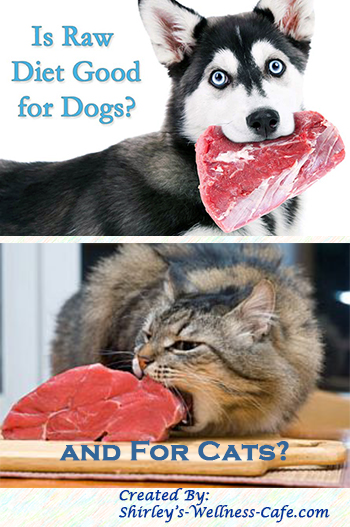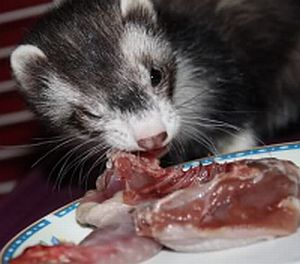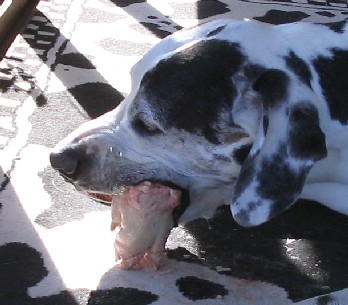The Optimum Diet for Animals
The better the nutrients we put into our body,
the better our body will perform. It is impossible to attain good health if we eat only processed foods,
sugars, and high carbohydrate diets. The same holds true for our pets.
I've seen amazing results and health improvement in my
dog Shasta simply by switching her diet to raw food. The raw food diet strengthened her
immune system dramatically. She no longer suffers from allergies to fleas and at 11 years of age her health
and vitality are radiant.
Dr. Swift DVM explains Why it's not a good idea to feed
cooked grains to your pets:"Carnivores cannot maintain
long term production of the quantity of amylase enzyme necessary
to properly digest and utilize the carbohydrates. In addition,
the proteins in grains are less digestive than animal proteins.

As a result, the immune system becomes irritated and weakened
by the invasion of foreign, non-nutritive protein and carbohydrate
particles. Allergies and other chronic immune problems may
develop. The pets pancreas will do its best to keep up with
the demand for amylase. What does this pancreatic stress
do over a long time? I don't know, but it cannot be good.
I suspect that dental calculus may be another problem promoted
by grain consumption."
Dr. Judy Morgan DVM -
"As a holistic veterinarian, I think the most important subject to address
with my patients is diet. After all, you are what you eat.
Related:
How To Create A Raw Dog Food Recipe
Concerned about salmonella and other bugs?
The digestive systems of dogs
and cats are short, acidic, and handle bacteria well. This is why
they are not susceptible to salmonella, parasites, or e-coli from
tainted meat as humans are. Humans have very long digestive tracks
which allow food to 'linger' for 24 hours or more, thus allowing
more time for parasites to get into their bloodstreams.
Some people add Fulvic acid minerals to their
pet's raw food diet. According to research, Fulvic neutralizes
toxins and can eliminate food poisoning within minutes.
When it encounters free radicals with unpaired positive or negative
electrons, it supplies an equal and opposite charge to neutralize
the free radical.
Fulvic acid acts as a refiner and transporter
of organic materials and cell nutrients. According to A. Szalay,
fulvic acid has the ability to dramatically detoxify herbicides,
pesticides, and other poisons that it interacts with – this includes
many radioactive elements. This detoxification process may extend to animals and humans.
So what to do when you can't feed your dog or cat raw food?
One alternative is
a natural grain-free kibble and canned food with organic chicken raised without hormones or steroids. This pet food is
free from corn, wheat, dairy, by-products, artificial colors or flavors.
It contains only natural, wholesome ingredients and is nutrient dense with vitamins, minerals, probiotics and is rich
with antioxidants from fruits, vegetables, flax seed meal, and other natural sources.

Much Healthier On A Raw Diet: a Testimonial
Darcie Krueger
I was born, grew up, lived and worked on ranches until
I was 27 years old. We grew our own food: meat, veggies, and fruit. Our
dogs got to eat whatever didn't make it into the freezer or onto the table...raw food.
I don't remember ever taking a dog to the
vet for anything. Our dogs lived to a ripe old age and worked cattle right along side us and our horses. It's kind of embarrassing for
me really. The fact is that I started feeding popular dog foods to my dogs after I moved to town. I should have known better. My
dogs were ill a lot, had bad, scratchy coats, allergy symptoms, icky teeth, really bad breath, some were fat, and some very, very
skinny.
The thing I remember most is that my dogs tried to tell me...we call it finicky but it's really the dog telling us the food
isn't good for them. Has your dog turned his nose up at his food? You probably did the same thing I did. Add a little gravy! Who knew
that those dog foods were bad for dogs?! The dogs did!
Changes in our dogs after starting raw food:
- Kari our Golden Retriever, rescued at 8 years old, grew
young again! She lived to be 17 years old. She passed away quietly
February 2002 of old age.
- Bruno (born 1994), our rescue boy, grew sleek and strong,
his nose turned black, quit having bellyaches, and he can breathe
again. Bruno can hold his own at a full run all day long.
- Dancer's (born 1995) fear of thunderstorms lessened from
uncontrollable fear to wanting a hug and she changed from a
skinny minny to a beautiful girl with a gorgeous coat.
- Tilli (born 1996) lost her baby fat that just wouldn't go
away no matter how much she exercised. Now she has an svelte
figure. She's the Frisbee dog. Energy galore.
We've only been to the vet for rabies shots, an old tooth that needed
to come out, and a broken leg. Remember when Bruno broke his leg
a few years ago? Recovered quickly. Our vet just couldn't believe
it. Quick healing, perfect blood work, and clean teeth. Kari had
a broken molar when she came to live with us. At 16 it finally started
to bother her. The vet couldn't believe how perfect her blood work
was and even gave us a discount on the surgery because her teeth didn't need cleaning.
Irradiated pet food endangering pets
 The Australian government in late May ordered an immediate stop to sterilizing
cat food via irradiation after reviewing scientific studies pointing to
food irradiation as the culprit behind illnesses characterized
by ataxia or paralysis of the limbs, especially the hind limbs.
Symptoms in the Australian cats first appeared three to six months
after they were exposed to the dry food, Child said.
The Australian government in late May ordered an immediate stop to sterilizing
cat food via irradiation after reviewing scientific studies pointing to
food irradiation as the culprit behind illnesses characterized
by ataxia or paralysis of the limbs, especially the hind limbs.
Symptoms in the Australian cats first appeared three to six months
after they were exposed to the dry food, Child said.
Some had eaten the food for as few as three weeks; others for more than six months.
The problem affected 90 cats in Australia, of which 30 died, mostly
by euthanasia after they became paraplegic or tetraplegic, according
to Dr. Georgina Child, a neurologist at the Small Animal Specialist
Hospital and University of Sydney Teaching Hospital. The U.S.
Food and Drug Administration (FDA) also allows animal feed, including
pet food and treats, to be irradiated up to 50 kGy.

Bones, Calcium and Phosphorous in Carnivore's Diet
Dr. Richard H. Pitcairn, D.V.M., Ph.D - "Dogs and cats, their kind
in the wild, eat a large amount of calcium. This happens because
they chew on, and swallow, bones which have large quantities of
calcium in their makeup. It is assumed that with time they have
adapted to having this kind of diet. It is not completely clear
that they must have this much calcium to be healthy. In other words,
perhaps they can adapt to lower levels. It certainly seems that
way for many of the animals I have known that, for one reason or
another, have had small amounts of calcium in their diets. They
often seem just fine."
There is evidence that the growing animal
is the one most sensitive to calcium deficiency. This makes sense
if we remember that it is during this time that the bones of the
body are rapidly enlarging. They are made up primarily of calcium
and phosphorus. In any case, it seems wise to supply the amounts
of calcium that are typical of the natural diet and our recipes
are formulated with that consideration. To give you some idea of
how much more calcium is "required" by a dog compared to a human
being, consider this comparison. The amount of calcium the average
woman needs is the same as that required by a small 10 lb.
 dog.
A larger dog, say a 100 lb. German Shepherd requires about 10 times
as much as this average woman. It is difficult to find sources of
calcium that can add this much to the diet. The natural source is bones and we find
that this is also the most ample source with which to formulate diets."
dog.
A larger dog, say a 100 lb. German Shepherd requires about 10 times
as much as this average woman. It is difficult to find sources of
calcium that can add this much to the diet. The natural source is bones and we find
that this is also the most ample source with which to formulate diets."
Feeding a Natural Diet
Christina Bredenkamp
Making the change to feeding raw foods can be so very traumatic
... to the owner! The dog would be very happy to acquire some nice
raw beef or chicken. But we, as the owners, make all of those decisions
for our pups. My own diet, which varies with what is available, consists mainly of turkey and chicken necks.
The turkey necks don't
have any fatty skins on them so I have to add fat to the diet. I do this by adding a few chicken necks which have lots of skin on
them. I also give chicken backs sometimes. They are very crunchy but also provide lots of fats.
Remember that these fats are from
natural sources. They have not been degraded by heating, causing them to
become rancid and unusable by the body. My 130# Dane bitch eats
2# of turkey necks and 3-4 chicken necks twice a day. I throw in
a chicken liver once a day or so. About every third meal I feed
a 1/2 pound veggie patty made according to Billinghursts' recipe.
My patties are packed and frozen in 1# weights (which for me provides
2 feedings) in sandwich ziplock baggies for ease of feeding.
The necks are packed and frozen in one gallon ziplock baggies with 4
- 5# of turkey and chicken necks in each. Again very easy to use.
I take what I need out of the freezer once a day and allow it to
thaw while the previous days' food is put into her 2 bowls for that
days' feeding.
If for some reason she won't eat a meal, it isn't a bad thing.
Fasting helps the body rest. Don't
sweat it. Just pick up the food within 20 minutes and return it
to the fridge for the next timed feeding. They are usually hungry
enough to eat the next time.
Of course, if your dog won't eat for a two days, something else is wrong and you need to find out what.
A trip to the vet is in order. One thing I no longer really worry
about is bloat. I still practice the usual precautions, but since
I am not feeding cereals that will swell up in the tummy and take
more than three times the digestion time needed (unnatural for a
dog's short digestive system designed for raw meats), I don't worry.
I have experienced bloat in 3 of my dogs (before feeding BARF).
I still watch for symptoms, etc. But now I don't worry. YEAH! Raw
foods pass through the stomach in 4 hours, not over 12. The enzymes
are still intact for use by the body to convert the food into nutritional
building blocks. It gets to the intestines quickly rather than spoiling
in the stomach trying to be digested into something that the dog
still can't use.
The changes you will see in your dog will amaze
you! Our allergies disappeared. Skin is smooth and supple with a
glossy coat. No greasy coats or infected ears. Wounds heal fast.
Fat turns to muscle. Stamina increases. Play increases. Vet bills
decrease. You have a happy, healthy dog.
Yes, you do need to watch for problems. Like turkey necks that
get thrown back up and re-eaten because they were so long! I cut
mine in half now because it grossed dear hubby to watch that. Too
large food chunks can also choke an animal, no matter what kind
of food is being fed. Do watch for bones being thrown up. They will
be undigested bones, nice and clean. Usually with grass. If your
dog wants to eat grass, then let it. They are doing it for a reason.
Usually because of a tummy upset. It also cleans out the colon.
 The grass catches the bones in the tummy that don't digest and helps
bring them out one way or the other. This can be a sign that you
need to cut back on the foods with bones and feed more veggies or
less bony foods. Also, they can pass bones in the stool and sometimes
that can cause problems. I don't feed meats with large/long bones
in them, like turkey legs or chicken legs and thighs. These are
weight bearing bones and can splinter more easily. The necks have
small bones that can pass through if undigested. I feel better with
this. They also contain lots of cartilage which is a natural source of
glucosamine and chondroiton. NEVER feed cooked bones. They all
splinter and can pierce the gut, causing a life threatening condition.
Try going the healthier route and give your dog a raw bone!
The grass catches the bones in the tummy that don't digest and helps
bring them out one way or the other. This can be a sign that you
need to cut back on the foods with bones and feed more veggies or
less bony foods. Also, they can pass bones in the stool and sometimes
that can cause problems. I don't feed meats with large/long bones
in them, like turkey legs or chicken legs and thighs. These are
weight bearing bones and can splinter more easily. The necks have
small bones that can pass through if undigested. I feel better with
this. They also contain lots of cartilage which is a natural source of
glucosamine and chondroiton. NEVER feed cooked bones. They all
splinter and can pierce the gut, causing a life threatening condition.
Try going the healthier route and give your dog a raw bone!
"My animals diet, which varies with what is available, consists
mainly of turkey and chicken necks. The turkey necks don't have
any fatty skins on them so I have to add fat to the diet. I do this
by adding a few chicken necks which have lots of skin on them. I
also give chicken backs sometimes. They are very crunchy but also
provide lots of fats. Remember that these fats are from natural
sources. They have not been degraded by heating, causing them to
become rancid and intolerable by the body."

Minerals and vitamin deficiency
Our soil, plants, and especially commercial foods are woefully
deficient in dietary key nutrients. Scientists theorize that mineral deficiency subjects
us, and our animals, to more diseases, aging, sickness and destruction
of our physical well-being than any other factor in personal health.
"In the wild, hair and under skin are part of a natural flesh diet
and supply essential roughage to exercise the strong muscles of
the digestive tract, acting also as a mild laxative....Animals in
the wild, after tearing off some outer skin and flesh of their victims,
unfailingly show a preference for certain organs of the body: first
the intestines, then the eyes. The intestines supply a good source
of semi-digested starch and green herbage.... The other chose organs
are the eyes, which animals gouge out with great eagerness. (Seagulls,
which are partly carnivorous, always greedily seek the eyes of drowned
bodies, animal or human.) It is no doubt some mineral salts which
attract the carnivorous animals, phosphorus and iodine normally
being present in the eye tissue.

Are Dogs Natural Fruit Eaters?
Nora Lenz, author of
No More Vet Bills, Raw Food Diet for Dogs and Cats
Some dogs are notorious for devouring almost any food put before
them, but if you've tried without success to feed fruit to your dog,
you may answer no to the above question. It turns out that personal
preference doesn't come close to settling the issue, however.
Whether or not fruits and vegetables are a natural part of the
canine diet remains a bone of contention among raw and home-feeding
dog owners.
Recent studies on the wolf, the closest living relative of todays
domestic dog, are shedding new light on the subject. Using telemetry
(satellite guided tracking), wolves can be followed so closely that
researchers can study exactly what they eat and when. One study,
Foraging and Feeding Ecology of the Gray Wolf, by Daniel R. Stahler,
Douglas W. Smith and Debra S. Guernsey tracked the eating habits
of wolves in Yellowstone National Park. Preliminary evidence suggests
that kill rates decrease as much as 25% in summer, when fruit and
other plant foods are available. Further studies exploring seasonal
changes in wolf predation are still underway.
 Yellowstone wolves tend to be more selective than wolves inhabiting
areas with more natural predator-to-prey ratios. Nevertheless, they
sometimes went without fresh meat for up to several weeks, according
to the study. In summer, fruit was available to fill in the gaps,
but in winter they subsisted by scavenging carcasses consisting
mostly of bone and hide.
Yellowstone wolves tend to be more selective than wolves inhabiting
areas with more natural predator-to-prey ratios. Nevertheless, they
sometimes went without fresh meat for up to several weeks, according
to the study. In summer, fruit was available to fill in the gaps,
but in winter they subsisted by scavenging carcasses consisting
mostly of bone and hide.
Although it differs by continent, studies on wolf scats have
shown evidence that wolves commonly eat a wide variety of fruits,
including berries, cherries, apples, pears, figs and grapes. Yes,
grapes!
The dietary classification for dogs usually boils down to the
question: Omnivore or carnivore? Actually, both are correct. Dogs
belong to a class of species called facultative carnivora, meaning
that they have all the faculties of a carnivore, but are able to
survive on foods other than prey, when necessary, for extended periods.
In practical terms, this classification is not distinguishable in
any meaningful way from omnivorism.
While fruits seem to be a natural variable in the canine diet,
the same cannot be said for vegetables, as a whole. The difference
is digestibility. The nutrients in vegetables are encased in a tough
cellulose membrane and require the kind of teeth that can chew and
grind them. Dogs aren't equipped with these, and they lack the digestive
enzymes that would do the trick in lieu of chewing. The only possible
exception to this is some starchy vegetables, which resemble overripe
fruit in composition when they are cooked. Examples would be yams,
sweet potatoes, squash and pumpkin.
 There is no doubt that prey has been the main preferred food
source for dogs throughout their biological history. However, scarcity
of prey has featured prominently enough to hold important clues
for modern dog owners seeking to feed their pets properly. If we
want to truly replicate nature, we have to feed prey foods only
as frequently as dogs have historically had access to them, on average.
Lacking that precise data, all we can do is estimate a range, based
on the evidence. The frequency end of the spectrum will be easier
to pin down than the infrequency end, since the latter is based
on fragmented information and will represent the elusive mean average
of all those occasions when dogs experienced prey scarcity. Giving
great consideration to widely varying individual factors like size,
condition and activity level of the dog being fed, optimal is likely
somewhere between 2-4 times weekly to a few times per month.
There is no doubt that prey has been the main preferred food
source for dogs throughout their biological history. However, scarcity
of prey has featured prominently enough to hold important clues
for modern dog owners seeking to feed their pets properly. If we
want to truly replicate nature, we have to feed prey foods only
as frequently as dogs have historically had access to them, on average.
Lacking that precise data, all we can do is estimate a range, based
on the evidence. The frequency end of the spectrum will be easier
to pin down than the infrequency end, since the latter is based
on fragmented information and will represent the elusive mean average
of all those occasions when dogs experienced prey scarcity. Giving
great consideration to widely varying individual factors like size,
condition and activity level of the dog being fed, optimal is likely
somewhere between 2-4 times weekly to a few times per month.
Wolves have been known to go as long as 6 months without a kill.
This is probably rare, admittedly, but it would be just as uncommon
for a wolf to eat his fill of prey everyday for days and months
on end, like many domestic dogs do. And it must be noted that wolves
are extremely physically active, unlike most domestic dogs.
Domestic dogs that are fed prey foods too regularly are often
overweight, sluggish, and symptomatic in one way or another. This
is true regardless of whether the food is raw or cooked, commercial
or home prepared, although dogs fed a homemade raw diet will have
far fewer health problems, of course. Often, these dogs will not
eat fruit. There is no reason for a dog to eat a secondary food
like fruit if primary foods are fed with such regularity as to produce
the conditioned expectation of getting them. When owners switch
to feeding prey foods on a more infrequent or random basis, and
particularly if appropriate fasting days are thrown in, they often
find that their dogs will eat fruits readily even though they shunned
them before.
When this kind of rotational feeding plan is implemented, owners
almost always see positive changes in their dogs as well, like increased
energy, shinier coat, better digestion and symptom cessation, especially
if only one type of food is fed per day (as opposed to mixing foods
together, which complicates digestion) and the foods are raw and
biologically appropriate.
Feeding fruit regularly is beneficial not only because it simulates
the gaps in primary food availability that a dog would experience
in nature, but for what fruits don't contain: namely, excess fat,
stored toxins, nutrient imbalances, etc. Even when dogs are raw-fed,
the foods that are produced in the modern meat industry cant ideally
meet their nutritional needs because they don't precisely resemble
what wild dogs have eaten throughout their history. For example,
humans have developed methods that produce food animals with a higher
than natural ratio of muscle to bone. Wild birds that are capable
of flying hundreds of miles have tiny breast muscles, while modern
domestic poultry that cant fly at all have huge mutated chests that
are only good for one thing – feeding humans. These manipulations
create nutritional excesses or imbalances in those who eat them,
even when the consumer is a carnivore.
 In addition,
producers often feed indigestible, inappropriate
foods and toxic substances that get stored in food animals fatty
tissues and cause problems when eaten by dogs. There are other problems,
too, like the lack of freshness, unavailability of whole animals
and finding food animals with bones that are small enough to either
be ground or chewed and consumed by small or medium-sized dogs.
Dogs need the entire bodies of prey, not just muscle meat.
In addition,
producers often feed indigestible, inappropriate
foods and toxic substances that get stored in food animals fatty
tissues and cause problems when eaten by dogs. There are other problems,
too, like the lack of freshness, unavailability of whole animals
and finding food animals with bones that are small enough to either
be ground or chewed and consumed by small or medium-sized dogs.
Dogs need the entire bodies of prey, not just muscle meat.
So for civilized dogs, fruit represents a valuable break from
the excesses inherent in modern foodstuffs. Fruit, in fact, is so
easy for a dog's body to break down that a day of only fruit allows
almost as much rest for the digestive tract as a fasting day. And
with modern dog owners being as reluctant as they typically are
to employ the crucial ‘famine part of the natural feast-and-famine
cycle that dogs are adapted to, fruit can provide the emotional
satisfaction of feeding while allowing digestive rest at the same
time.
The idea that plant foods actually represent a larger proportion
of a dog's natural diet than previously supposed would explain the
anecdotal success that some people are enjoying raising vegan and
vegetarian dogs, as well. For dog owners wanting to minimize the
use of animal products for ethical, ecological or financial reasons,
feeding meat less frequently in favor of fruit and other appropriate
plant fare offers this opportunity while not compromising the health
of the dog. Even if owners are not constrained by such concerns
and wish only to keep their dogs in optimal health, fruit can be
an important piece of the puzzle.